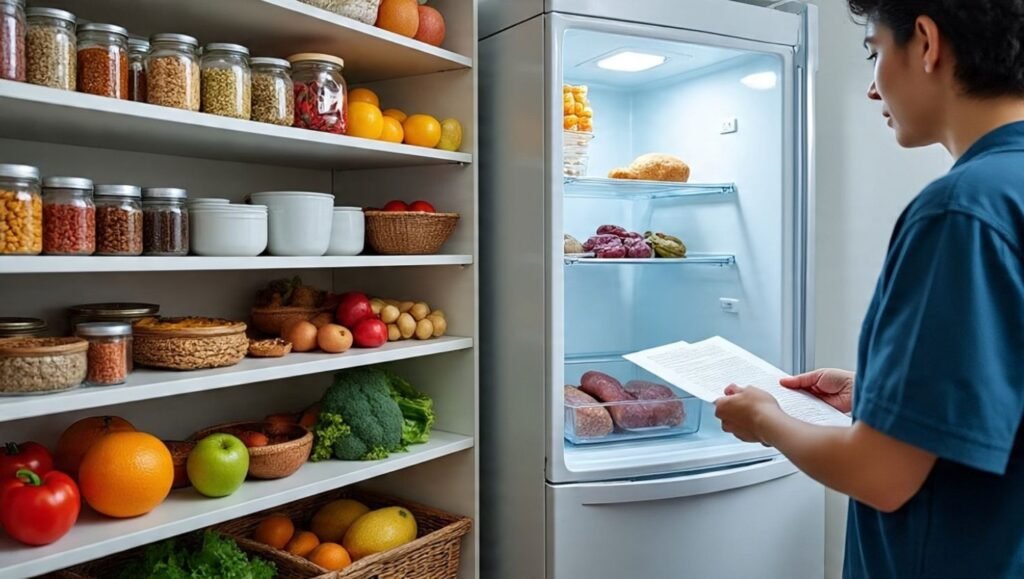7 Tricks to Plan a Week of Meals Cheaply

Planning a week’s worth of meals doesn’t have to drain your wallet or your energy. With a few smart strategies, you can cut grocery costs, reduce waste, and still enjoy nutritious, delicious meals every day. Whether you’re feeding a large family or just yourself, learning how to budget meals effectively makes a big difference.
This guide shares practical meal prep tips, shopping tricks, and planning ideas that make your kitchen routine more efficient and affordable. You’ll also discover how to use leftovers creatively, take advantage of seasonal produce, and build weekly menus without stress. Let’s dive into these 7 powerful tricks to plan meals on a budget like a pro!
Why Budget Meal Planning Matters

Many families today are looking for ways to save money on groceries. The price of food is rising, and eating out adds up quickly. With a good plan, you can create affordable meal planning strategies that work every week. Not only will this save money, but you’ll also eat healthier and cut down on food waste. Studies show that meal planners spend less at the store and make fewer unhealthy food choices.
It’s a myth that healthy meals on a budget aren’t possible. In fact, when you take time to plan and shop smart, you’ll be amazed by how easy it is to cook tasty, low-cost meals. That’s where this article will help. From making a smart grocery list to using what’s already in your pantry, each tip is easy to follow and very effective.
Step-by-Step Meal Planning for Beginners
To start weekly meal planning, take a look at your week. Do you have busy nights? Will you be home for dinner every evening? Once you understand your schedule, it’s easier to create a meal plan that fits. Write down how many meals you’ll need for breakfast, lunch, and dinner.
Next, make a list of items you need. Think about simple meals that share ingredients. For example, you can use chicken for tacos one night and soup the next. This kind of smart planning saves both time and money. Don’t forget to plan for snacks too. You’ll avoid impulse buys when you shop with a clear plan.
Shop Your Pantry, Fridge, and Freezer First

Before heading to the store, check pantry, refrigerator and freezer for food you already have. Many people forget about ingredients hiding in the back of shelves. Use up older items before they go bad. This is called use what you have cooking, and it’s one of the best ways to reduce waste.
It helps to create a simple pantry inventory. Keep track of canned goods, grains, and frozen veggies. Then, look for recipes using what you already have. If you have pasta and canned tomatoes, search for a recipe that uses both. This makes shopping easier and your meals cheaper.
Build a Simple, Flexible Meal Plan
Don’t make meal planning too hard. Keep things simple with meals you know how to cook. Start with your family’s favorite meals and add one or two new ones each week. That way, you’ll enjoy variety without getting overwhelmed. Involve your family in meal planning so everyone feels excited about what’s coming to the table.
Also, be flexible. Life happens! If you can’t cook one night, move the meal to another day. Keep one or two easy meals on hand, like sandwiches or frozen leftovers, for busy evenings. Over time, you’ll learn what works best for you.
Choose Budget-Friendly Ingredients
Always plan your meals around foods that are on sale. Look through store flyers and discounts to see what’s cheap this week. Then plan your meals using those ingredients. For example, if chicken is on sale, plan two or three meals using it. This is smart grocery list planning in action.
Try to avoid expensive, one-use ingredients. Avoid special ingredients you’ll only use once because they just take up space and go to waste. Instead, pick inexpensive ingredients like rice, pasta, and beans. They are filling, easy to cook, and work with many recipes. Here’s a quick table showing cost-effective foods:
Budget-Friendly Food Items
| Food Item | Average Price (USD/lb) | Uses |
|---|---|---|
| Rice | $0.80 | Stir-fry, soups, sides |
| Lentils | $1.10 | Soups, salads, stews |
| Eggs | $1.50 (dozen) | Breakfast, baking, protein source |
| Canned Tuna | $1.00 (per can) | Sandwiches, pasta, salads |
| Frozen Veggies | $1.20 (per bag) | Stir-fry, casseroles, soups |
Include Plant-Based Meals and Protein Alternatives
Adding more plant-based meals can really help your budget. Choose plant-based proteins like lentils, beans, tofu, and peanut butter. These foods are cheap, full of protein, and easy to use in many recipes. Meals like lentil soup or bean chili are perfect for cold nights and cost just pennies per serving.
If your family eats meat, try using less of it. Mix meat with beans in tacos or use a small amount in pasta. Frugal cooking means making tasty meals without wasting ingredients or money. And don’t forget about seasonal fruits and vegetables, which are cheaper and taste better.
Batch Cook and Use Leftovers Smartly
One of the best tips for cooking on a budget is to cook in batches and freeze portions. When you make a big pot of chili or soup, freeze extra servings for later. This saves time and money on nights when you’re too tired to cook. You’ll also waste less food this way.
Also, use leftovers creatively. Turn roast chicken into sandwiches, salad, or soup. This is called leftover recipes planning. Don’t let food go to waste—leftovers can be your best friend if you use them right. Here’s a few ideas to help:
Creative Leftover Meal Ideas
| Original Meal | Leftover Idea |
|---|---|
| Roast Chicken | Chicken Salad Wraps |
| Beef Stir-fry | Fried Rice or Noodles |
| Baked Vegetables | Veggie Omelet |
| Cooked Rice | Rice Pudding or Stir-fry |
Final Tips to Stick With It
It may seem like a lot at first, but with practice, menu planning becomes quick and easy. Stick your plan on the fridge so you can see it. Don’t forget to check your plan each morning so you know what to prep. Small steps like this help build habits that last.
Balanced meals with fruits, grains, and protein are key to staying healthy while saving money. If you’re ever unsure, a dietitian can help with personalized advice. They can show you how to make meals that fit your health goals and budget too.
With these meal prep ideas and smart tricks, you’ll have everything you need to enjoy cost-effective meals every week. Take control of your food, your health, and your spending—all with one simple plan.
Frequently Asked Questions:
✅ Final Thoughts: Smart Planning, Big Savings
Meal planning on a budget isn’t about cutting corners—it’s about cooking smarter. With the right strategy, you can enjoy delicious, balanced meals without overspending. From checking your pantry to embracing leftovers, every step brings you closer to healthier habits and bigger savings. Start small, stay consistent, and don’t forget to download your free Weekly Meal Planner to make things even easier. You’ve got this! 💪🍽️






